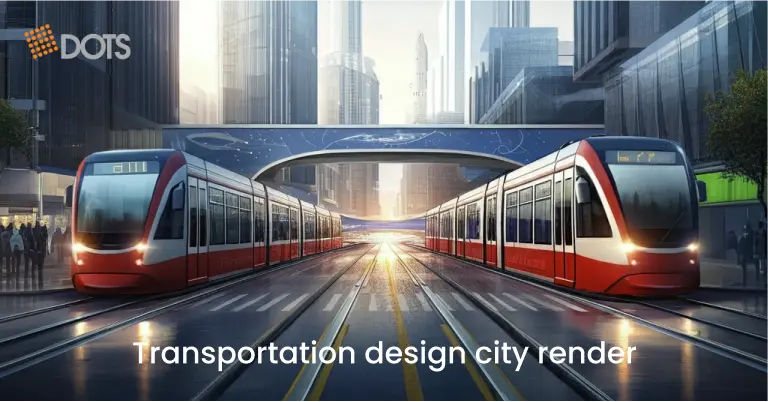How Are 3D Renders Transforming City Transportation Design?
By: Muthukumar
Last Updated: December 1, 2024

Discover how 3D renders revolutionize city transportation design through immersive visuals, collaboration, and sustainability. What's their role in urban mobility?
Table of Contents
3D Renders That Transform City Transportation Designs
As cities worldwide continue to grow and evolve, the need for efficient, sustainable, and reliable transportation systems has become increasingly significant. The integration of innovative technologies and creative design thinking has given rise to a new era of urban mobility. At the very top of this revolution are 3D renders, which have transformed the way city transportation designs are conceptualized, visualized, and executed.
With the power to bring ideas to reality, 3D renders have enabled urban planners, architects, and engineers to experiment with novel transportation solutions, test their feasibility, and communicate their vision to stakeholders. From sleek, driverless metro lines to futuristic, elevated bike highways, 3D renders have unlocked a totally new world of possibilities for city transportation design. In this blog, we'll delve into the exciting world of 3D renders and explore how they're transforming city transportation designs.
The Power of 3D Renders that Transform City Transportation Designs
3D renders have become an extremely important tool for urban planners, architects, and engineers. These visualizations enable designers to experiment with innovative and convenient transportation solutions, test their feasibility, and communicate their vision to stakeholders. With 3D renders, designers can:
Create immersive and interactive experiences, allowing stakeholders to explore and understand complex transportation systems.
Test and refine designs in a virtual environment, reducing the need for physical prototypes and minimizing costs.
Communicate design intent and vision to stakeholders, facilitating collaboration and ensuring that all parties are aligned.
Applications of 3D Renders in Transportation Design
S. No | Category | Context |
1 | Urban Planning | 3D renders are used to design and visualize urban transportation systems, including roads, highways, public transportation systems, and pedestrian infrastructure. |
2 | Transportation Infrastructure | 3D renders are used to design and visualize transportation infrastructure, including bridges, tunnels, airports, and seaports. |
3 | Public Transportation | 3D renders are used to design and visualize public transportation systems, including buses, trains, and subways. |
4 | Pedestrian and Cyclist Infrastructure | 3D renders are used to design and visualize pedestrian and cyclist infrastructure, including sidewalks, bike lanes, and pedestrianized streets. |
The Future of 3D Renders in Transportation Design
Here's an in-depth look at the future of 3D renders in transportation design: 1) Trends Shaping the Future:-
Increased Adoption of Virtual and Augmented Reality:
The use of virtual and augmented reality technologies will become more prevalent in transportation design, enabling stakeholders to immerse themselves in 3D environments.
Integration with Building Information Modelling (BIM):
3D renders will be integrated with BIM to create a more comprehensive and accurate representation of transportation designs.
Use of Artificial Intelligence and Machine Learning:
Artificial intelligence and machine learning algorithms will be used to analyze and optimize transportation designs, enabling stakeholders to make data-driven decisions.
1) Trends Shaping the Future
Increased Adoption of Virtual and Augmented Reality: The use of virtual and augmented reality technologies will become more prevalent in transportation design, enabling stakeholders to immerse themselves in 3D environments.
Integration with Building Information Modelling (BIM): 3D renders will be integrated with BIM to create a more comprehensive and accurate representation of transportation designs.
Use of Artificial Intelligence and Machine Learning: Artificial intelligence and machine learning algorithms will be used to analyse and optimize transportation designs, enabling stakeholders to make data-driven decisions.
2) Emerging Technologies
Real-Time Rendering:
Real-time rendering technologies will enable designers to create interactive, real-time 3D visualizations of transportation designs.
Cloud-Based Rendering:
Cloud-based rendering technologies will enable designers to access powerful rendering capabilities on-demand, reducing the need for expensive hardware and software.
Generative Design:
Generative design technologies will enable designers to create multiple design options based on a set of parameters, enabling the rapid exploration of design alternatives.
3) Future Applications
Smart Cities:
3D renders will play a critical role in the design and development of smart cities, enabling stakeholders to visualize and verify complex transportation systems.
Autonomous Vehicles:
3D renders will be used to design and test autonomous vehicle systems, enabling stakeholders to simulate and analyse complex scenarios.
Sustainable Transportation:
3D renders will be used to design and optimize sustainable transportation systems, enabling stakeholders to reduce carbon emissions and promote eco-friendly transportation solutions.
The Benefits of 3D Renders that transform Transportation Designs
S. No. | Category | Context |
Improved Visualization and Communication | ||
1 | Enhanced stakeholder engagement | 3D renders facilitate communication among stakeholders, ensuring that all parties are aligned and working towards a common goal. |
2 | Clearer design intent | 3D renders provide a clear and concise representation of transportation designs, enabling stakeholders to understand complex systems. |
3 | Better decision-making | 3D renders enable stakeholders to make informed decisions by providing a detailed and accurate representation of transportation designs. |
Increased Efficiency and Productivity | ||
1 | Reduced design time | 3D renders enable designers to test and refine designs in a virtual environment, reducing the need for physical prototypes and minimizing costs. |
2 | Improved collaboration | 3D renders facilitate collaboration among stakeholders, reducing misunderstandings and miscommunications. |
3 | Enhanced design optimization | 3D renders enable designers to optimize transportation designs, reducing costs and improving performance. |
Enhanced Sustainability and Safety | ||
1 | Sustainable design | 3D renders enable designers to create sustainable transportation designs, reducing carbon emissions and promoting eco-friendly transportation solutions. |
2 | Improved safety | 3D renders enable designers to identify and mitigate potential safety risks, creating safer transportation systems. |
3 | Reduced environmental impact | 3D renders enable designers to minimize the environmental impact of transportation designs, reducing waste and promoting sustainable development. |
Cost Savings and ROI | ||
1 | Reduced costs | 3D renders reduce the need for physical prototypes, minimizing costs and improving ROI. |
2 | Improved ROI | 3D renders enable designers to optimize transportation designs, reducing costs and improving performance. |
3 | Increased ROI | 3D renders enable stakeholders to make informed decisions, reducing the risk of costly mistakes and improving ROI. |
Conclusion
In conclusion, 3D renders are revolutionizing the field of city transportation design, enabling stakeholders to create more sustainable, efficient, and futuristic transportation systems. By utilizing 3D renders, designers can experiment with novel transportation solutions, test their feasibility, and communicate their vision to stakeholders. The benefits of 3D renders in transportation design are numerous, including improved visualization and communication, increased efficiency and productivity, enhanced sustainability and safety, and cost savings and ROI.
As cities worldwide continue to grow and evolve, the need for innovative and effective transportation solutions has become increasingly pressing. 3D renders offer a powerful tool for addressing this challenge, enabling stakeholders to create transportation systems that are tailored to the unique needs of their cities. By embracing 3D renders, cities can create transportation systems that are not only functional and efficient but also sustainable, safe, and visually stunning. Ultimately, the transformative power of 3D renders has the potential to reshape the urban landscape, creating cities that are more reliable, sustainable, and connected.

